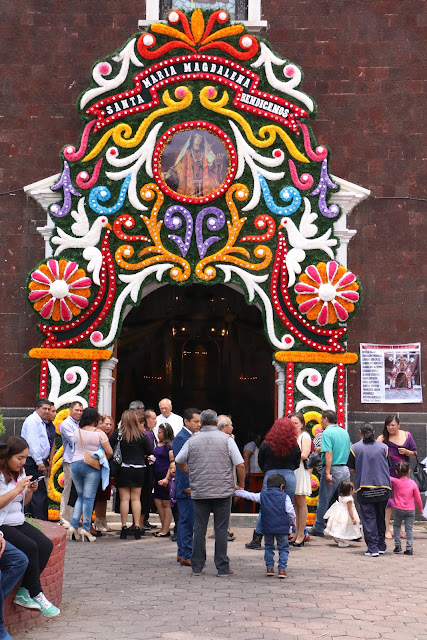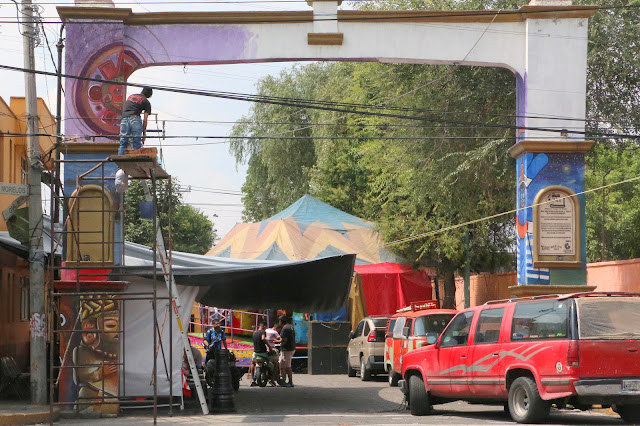Islands in a Lake
We learned in our earlier exploration of the original barrios of the island city of Tenochtitlan, that the Mexicas actually built their island capital in Lake Texcoco by cobbling together five islands (yellow areas on the map below), by inserting wood pilings into the lake bed and filling them with soil (light orange). Around this more or less solid land, they extended chinampas (dark orange), similarly filled pilings used to create small man-made islands for agricultural land to supply the city. The city itself and the chinampas were crisscrossed by canals.
The most southern island incorporated into the city was that of Tultengo, at the southern end of the quarter of Tenochtitlan known as Teopan-Zoquipan. It was totally surrounded by chinampas. We visited Tultengo's urban remains earlier this year. To the southeast of Tultengo, but not connected to the city, lay another island, Mixiuhcan. It is now the core of Pueblo Magdalena Mixhuca, in Delegacion (Borough) Venustiano Carranza, named after the first president after the Mexican Revolution. Except for Mixiuhcan and some other islands, the delegación was originally all lake bed. We have been eager to explore Magdalena Mixhuca for some time.
 |
| Características edíficas y ecológicas presentes en la isla de Tenochtitlan-Tlatelolco. Soil and ecological characteristics of the Island of Tenochtitlan-Tlatlolco (based on data from Calnek 1972, 1976; González Aparicio 1980, Reyes García et al. [eds.] 1996, Filsinger 2005, Sánchez Vázquez et al. 2007) from: SAN PABLO TEOPAN: PERVIVENCIA Y METAMORFOSIS VIRREINAL DE UNA PARCIALIDAD INDÍGENA DE LA CIUDAD DE MÉXICO by ROSSEND ROVIRA MORGADO San Pablo Teopan: Survival and Metamorphosis of an Indigenous Quarter of Mexico City During the Viceroy Period by Rossend Rovira Morgado |
Pueblo Santa María Magdalena Mixhuca
A few months ago, we went on an Amble to some of the city's larger indoor markets located near the former La Viga Canal which, for centuries after Lake Texcoco was drained by the Spanish, was the main supply route from the chinampas of Lake Xochimilco to the south into the central city. While in the area, we realized that we were near Pueblo Magdalena Mixuca. So we walked a couple of blocks from the Mercado de Peces (the market for aquarium fish) to the Church of Santa María Magdalena Mixhuca. As it was a Saturday, the neighborhood was quiet.
 |
| A small, pleasant plaza, with a kiosk, stands in front of the church, whose bell tower can be seen at the rear, center. The plaza and church are typical components of the center of an original pueblo. |
 |
| Church of Santa María Magdalena Mixhuca An enclosed atrio, atrium, stands in front of the church. |
Original Location of Mixihucan
 |
| The Valley of Anahuac and its lakes, at the time of the arrival of the Spanish in 1519. In Lake Texcoco, southeast of Tenochtitlan, was a group of islands (blue star). Mixihucan was one of them. |
The church is under the patronage of Santa María Magdalena, one of Jesus' few named original female followers. Our ambles have taught us that the best way to experience a pueblo at its liveliest is to return on the patron saint day—in this case, at the end of July.
So on July 22nd, we returned. We recalled the entrance to the pueblo, a block north of el Mercado de Peces, to be a typically nondescript calleja, side street, leading into a working class neighborhood. This time we were surprised to catch sight of a permanent archway at the entrance to the calleja just west of the one we had entered the first time.
Celebrating Indigenous Roots
 |
| The young artist is creating the Nahua symbol of Ollin, (Oh-YEEN), the eternal, cyclical energy of the universe |
 |
| Another Ollin is on one side of a pillar of the arch. |
 |
| Tlaloc, God of All Waters |
 |
| Mictlantecuhtli God of the Underworld with his xoloitzcuintle, the hairless dog that leads the dead to the underworld |
 |
| The watery world that once was Mixhuca is portrayed on yet another side of the archway. |
Although the painting of the archway is obviously a work very much in progress, it is a strong statement of the pueblo's continuing awareness of and pride in its indigenous roots.
After taking our photos, we pass under the arch and make our way up the street, filled with the carnival rides and food booths typical of a fiesta.
As we reach the plaza, we realized that a comparsa, a troop of Aztec or conchero dancers (from the lute-like stringed instruments they play, originally made from armadillo shells) has just finished its dance and is leaving. But we manage to capture the rostros, countenances, of some of them as they walk from the plaza in formal procession.
Moving through the small, crowded plaza toward the church atrio, we are stopped in our tracks by another representation of Mixhuca's indigenous heritage. Over the atrio entrance, instead of the usual floral portada arch, is a truly stunning work of indigenous art and ancient symbology created solely with beans and seeds. The arch is a striking echo of the painting currently underway on the gateway at the entrance to the pueblo.
We wish we could find someone who could explain the symbology of this mural, but the people in the plaza are busy selling and buying food, the temporary tianguis, street market, that is another ancient part of a Mexican fiesta, and seem oblivious to the masterpiece above their heads.
The Franciscans and other religious orders that came from Spain in the 16th and 17th centuries to transform an autochthonous "pagan" people and their culture into a Spanish Catholic European one employed a strategy of establishing parallels between Christian rituals and symbols and indigenous ones. The resulting combination or syncretism of belief systems has come to be called the Spiritual Conquest.
This "conquest", and the conflict of cultures which it attempted to resolve, is quite literally apparent in the juxtaposition of the indigenous mural, centered on the God of Death, and the traditional floral portada, archway, around the church doorway, about 75 feet behind it, across the church atrio. This second portada celebrates the pueblo's patron Catholic saint, Mary Magdalene, one of the first to witness the Christ who had risen from the grip of death. This stark juxtaposition of Death and Life remains central to Mexican culture.
Mixhuacan
(here labled Mixlucan)
is immediately southeast of Tenochtitlan.
Map from magazine Arqueología Mexicana
After taking our photos, we pass under the arch and make our way up the street, filled with the carnival rides and food booths typical of a fiesta.
 |
| Making tortillas, a millennial-old activity. |
Indigenous Gods Stand in Front of Christian Saints
Moving through the small, crowded plaza toward the church atrio, we are stopped in our tracks by another representation of Mixhuca's indigenous heritage. Over the atrio entrance, instead of the usual floral portada arch, is a truly stunning work of indigenous art and ancient symbology created solely with beans and seeds. The arch is a striking echo of the painting currently underway on the gateway at the entrance to the pueblo.
 |
| A Nahua god |
 |
| Mictlantecuhtli, God of Death holds center place. |
 |
| Another Nahua god |
The Franciscans and other religious orders that came from Spain in the 16th and 17th centuries to transform an autochthonous "pagan" people and their culture into a Spanish Catholic European one employed a strategy of establishing parallels between Christian rituals and symbols and indigenous ones. The resulting combination or syncretism of belief systems has come to be called the Spiritual Conquest.
This "conquest", and the conflict of cultures which it attempted to resolve, is quite literally apparent in the juxtaposition of the indigenous mural, centered on the God of Death, and the traditional floral portada, archway, around the church doorway, about 75 feet behind it, across the church atrio. This second portada celebrates the pueblo's patron Catholic saint, Mary Magdalene, one of the first to witness the Christ who had risen from the grip of death. This stark juxtaposition of Death and Life remains central to Mexican culture.
 |
| Beyond the mural, the entrance to the church is visible, with a more traditional floral portada. The church is built of tezontle, red volcanic rock typical of the Valley of Mexico. |
Ancient Rites Transformed into Catholic Christianity
 |
| "Saint Mary Magdalene, bless us." |
 |
| A wedding is about to begin. |
 |
 |
| The sanctuary is decorated for the fiesta, including the traditional abundance of flowers. |
 |
| St. Mary Magdalene For her patron saint day, she is removed from her usual niche behind the altar and specially dressed. |
 |
| A simpler portada stands above the altar. "You are the bread of eternal life." "Thanks for your protection and shelter, St. Mary Magdalene." |
 |
| The wedding is immediately followed by a first communion, the initiation into the faith. (Who could not be delighted by these pubescent boys?) |
Another Meeting of Indigenous Beliefs and Spanish Catholicism
So here, in Pueblo Santa María Magdalena Mixhuca, on what was once an island in Lake Texcoco and is now a working class neighborhood of a contemporary metropolis, we once again encounter the present-day manifestation of the Spiritual Conquest, that synthesis of ancient, indigenous beliefs and symbols with Spanish Catholicism.
We are always amazed and humbled by how this five-hundred-year-old dynamic continues to be maintained and, even more, celebrated with great animo, spirit and orgullo, pride, in over a hundred originally indigenous pueblos and barrios that are now often virtually hidden but still alive within the City called Mexico.
 |
| Delegación Venustiano Carranza is the lime green area in northeast of the City, just east of Delegación Cuauhtémoc, site of Centro /Tenochtitlan. |
Mixhuacan
(here labled Mixlucan)
is immediately southeast of Tenochtitlan.
Map from magazine Arqueología Mexicana







No comments:
Post a Comment